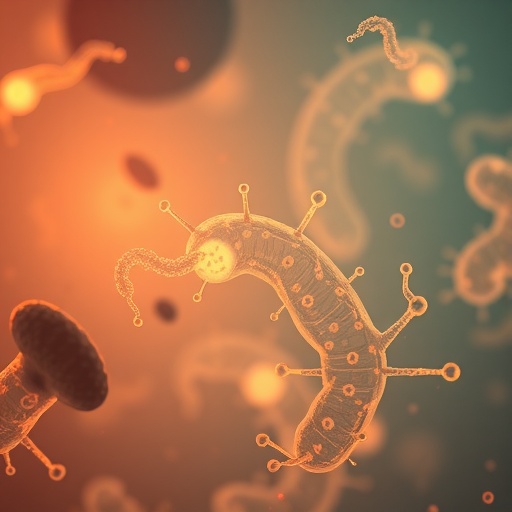Scientists Unveil Revolutionary Living Biosensor for Rapid Detection of Microplastic Pollution in Water
Microplastic pollution has emerged as one of the most insidious environmental challenges of the 21st century, infiltrating ecosystems across the globe—from the deepest ocean trenches to city waterways. These microscopic fragments, often invisible to the naked eye, pose considerable threats to aquatic life and human health. Current methodologies for quantifying and identifying microplastics in environmental samples, although precise, generally require elaborate procedures, expensive instrumentation, and considerable expertise, limiting their scalability and rapid deployment. In a groundbreaking study set to be published in ACS Sensors, researchers have engineered a living microbial biosensor that harnesses bioluminescence to detect microplastics in water samples swiftly and inexpensively, marking a significant leap forward in environmental monitoring technology.
The core of this innovation lies in the genetic modification of the common bacterium Pseudomonas aeruginosa, a species known for its natural propensity to colonize plastic surfaces by forming biofilms. By equipping these bacteria with two synthetic genes, the scientists created a bioengineered organism capable of sensing the presence of plastic materials in aquatic environments. One gene encodes a plastic-contact-activated protein that triggers a downstream genetic circuit, while the second gene instructs the bacterium to produce a green fluorescent protein (GFP) upon activation. This fluorescence effectively acts as a visible signal, allowing researchers to detect microplastics without the need for complex sample processing or expensive analytical devices.
In controlled laboratory assays, the engineered P. aeruginosa demonstrated remarkable specificity and sensitivity. When introduced into vials containing various polymers such as polyethylene terephthalate (PET) and polystyrene, the bacteria were observed to emit a green fluorescence within three hours, indicating successful recognition and binding to microplastic particles. Crucially, the biosensor did not activate when exposed to unrelated materials like glass or sand, underscoring its selectivity for synthetic polymers. The fluorescence intensity correlated with the quantity of plastic present, enabling semi-quantitative assessments of microplastic concentrations.
A technically vital aspect of this biosensor’s utility is its durability and practicality for field use. The modified bacterial cells retained their viability and response capabilities after refrigeration at 4 °C for up to 72 hours, an attribute that simplifies transport and storage logistics for environmental monitoring teams. This flexibility potentially facilitates the deployment of the biosensor in remote locations, expanding the reach of microplastic detection efforts beyond centralized laboratories.
The research team extended their study beyond laboratory conditions by applying the biosensor to real-world seawater samples collected from urban waterways. Prior to analysis, these samples underwent filtration to remove large particulates and chemical treatment to degrade organic matter that might interfere with the bacteria’s sensing mechanism. Upon exposure to the biosensor, certain samples exhibited significant green fluorescence, corresponding to microplastic pollution levels as high as 100 parts per million. Subsequent Raman microspectroscopy analysis of the same samples identified the microplastics primarily as biodegradable polymers such as polyacrylamide, polycaprolactone, and methyl cellulose, substantiating the biosensor’s capability to detect a range of polymer types beyond standard petroleum-derived plastics.
This convergence of synthetic biology and analytical chemistry illustrates an innovative approach to environmental diagnostics. Traditional microplastic detection instruments like Fourier-transform infrared (FTIR) spectroscopy and Raman spectroscopy, while robust and detailed, often require intricate sample preparations, including filtration, drying, and microscopic examination, which collectively contribute to high time and cost burdens. The engineered biosensor offers a streamlined preliminary detection step that can rapidly screen large batches of samples with minimal requirements, allowing researchers to prioritize samples for further specialized analyses accordingly.
Moreover, the study provides insight into the molecular mechanisms exploited to achieve selective microplastic detection. The engineered protein sensor exploits specific bacterial surface receptor interactions that occur preferentially with plastic polymers, triggering the promoter region connected to the GFP gene. The synthetic genetic circuit amplifies this signal, converting a biochemical detection event into an optical one that can be quantified by fluorescence spectroscopy or even simple visual inspection with appropriate light filters.
The implications of this technology extend beyond environmental monitoring. As microplastic contamination becomes intricately linked to public health concerns through bioaccumulation and potential toxicological effects, rapid field-deployable sensors could enable regulatory bodies, conservationists, and communities to make informed decisions based on timely data. Early warnings of pollution hotspots can facilitate targeted interventions, such as cleanup operations or policy enactment, ultimately contributing to the mitigation of plastic pollution’s adverse impacts.
Future work proposed by the researchers involves refining the biosensor’s sensitivity and specificity to capture even lower microplastic concentrations, expanding its repertoire of detectable polymer types, and integrating the system into portable devices for on-site analyses. Such advancements could democratize environmental sensing efforts by reducing reliance on centralized laboratories and enabling citizen science initiatives.
This pioneering living sensor demonstrates a compelling example of how synthetic biology can intersect with environmental science to create sustainable, efficient, and accessible solutions. Through leveraging the natural tendencies of bacteria and augmenting their genetic toolkit, the research team has engineered a novel pathway to illuminate the invisible threat of microplastics—literally “shedding light” on pollution through the glow of genetically programmed microbes.
“Our biosensor provides a rapid, cost-effective, and user-friendly platform for detecting microplastics,” states lead author Song Lin Chua. “This tool fits seamlessly into existing environmental monitoring frameworks and has the potential to dramatically expand our capabilities to assess and address plastic pollution on both local and global scales.”
As the scientific community and the public continue to grapple with the pervasive challenge of plastic contamination, innovations such as this microbial biosensor offer hope for more responsive and informed environmental stewardship. The study stands as a testament to the synergistic possibilities unleashed when biology, chemistry, and engineering converge in service of ecological sustainability.
Subject of Research: Microplastic pollution detection using genetically engineered microbial biosensors
Article Title: Detection of Microplastics Pollution Using a Green Fluorescent Protein-Based Microbial Biosensor Coupled with Raman Spectroscopy
News Publication Date: September 3, 2025
Web References: http://dx.doi.org/10.1021/acssensors.5c01120
Image Credits: Song Lin Chua
Keywords
Chemistry, Plastics, Sensors, Pollution




